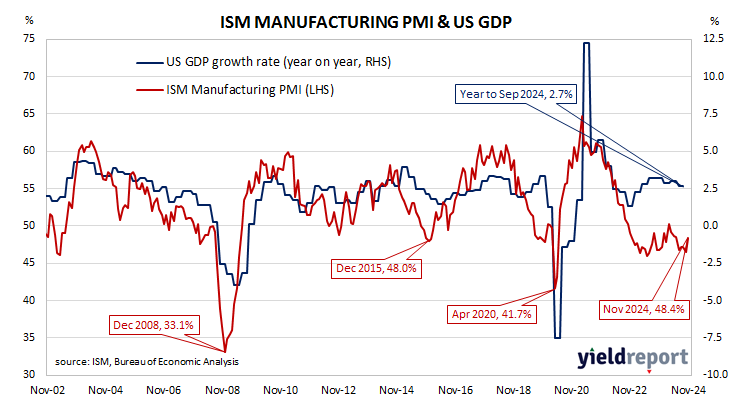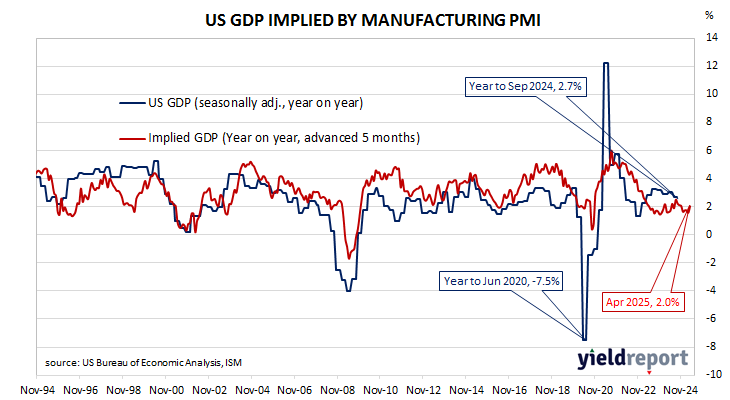Summary: ISM manufacturing PMI up in November, above expectations; ISM: activity contracts again but at slower rate; US Treasury yields rise; expectations of Fed rate cuts soften; Westpac: new orders index up above 50; ISM: reading corresponds to 1.7% US GDP growth annualised.
The Institute of Supply Management (ISM) manufacturing Purchasing Managers Index (PMI) reached a cyclical peak in September 2017. It then started a downtrend which ended in March 2020 with a contraction in US manufacturing which lasted until June 2020. Subsequent month’s readings implied growth had resumed, with the index becoming stronger through to March 2021. Readings then declined fairly steadily until mid-2023 and have since generally stagnated.
According to the ISM’s November survey, its manufacturing PMI recorded a reading of 48.4%, above the generally expected figure of 47.6% as well as October’s reading of 46.5. The average reading since 1948 is roughly 53.0% and any reading below 50% implies a contraction in the US manufacturing sector relative to the previous month.
“US manufacturing activity contracted again in November, but at a slower rate compared to last month,” said Timothy Fiore of the ISM Manufacturing Business Survey Committee. “Demand continues to be weak but may be moderating, output declined again and inputs stayed accommodative.”
US Treasury bond yields rose modestly across the curve on the day. By the close of business, the 2-year Treasury bond yield had gained 2bps to 4.18%, the 10-year yield had added 1bp to 4.19% while the 30-year yield finished 3bps higher at 4.40%.
In terms of US Fed policy, expectations of a lower federal funds rate in the next 12 months softened, although three 25bp cuts are still almost fully priced in. At the close of business, contracts implied the effective federal funds rate would average 4.50% in December, 4.425% in January and 4.38% in February. November 2025 contracts implied 3.85%, 73bps less than the current rate.
“The new orders index was up solidly to 50.4, the first reading above 50 in eight months,” noted Westpac economist Jameson Coombs. “Manufacturers responded by advancing their hiring, with the employment index also rising.”
Purchasing managers’ indices (PMIs) are economic indicators derived from monthly surveys of executives in private-sector companies. They are diffusion indices, which means a reading of 50% represents no change from the previous period, while a reading under 50% implies respondents reported a deterioration on average. A reading “above 42.5%, over a period of time, generally indicates an expansion of the overall economy” according to the ISM’s most-recent estimate.
The ISM’s manufacturing PMI figures appear to lead US GDP by several months despite a considerable error in any given month. The chart below shows US GDP on a “year on year” basis (and not the BEA annualised basis) against US GDP implied by monthly PMI figures.
According to the ISM and its analysis of past relationships between the PMI and US GDP, November’s PMI corresponds to an annualised growth rate of 1.7%, or about 0.4% over a quarter. Regression analysis on a year-on-year basis suggests a 12-month GDP growth rate of 2.0% five months after this latest report.
The ISM index is one of two monthly US PMIs, the other being an index published by S&P Global. S&P Global produces a “flash” estimate in the last week of each month which comes out about a week before the ISM index is published. The S&P Global November flash manufacturing PMI registered 48.8%, up 0.3 percentage point from September’s final figure.



